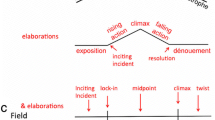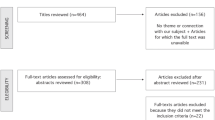Abstract
We introduce the question whether there are specific kinds of writing modalities and practices that facilitated the development of modern science and mathematics. We point out the importance and uniqueness of symbolic writing, which allowed early modern thinkers to formulate a new kind of questions about mathematical structure, rather than to merely exploit this structure for solving particular problems. In a very similar vein, the novel focus on abstract structural relations allowed for creative conceptual extensions in natural philosophy during the scientific revolution. These preliminary reflections are meant to set the stage for the following contributions in this volume.
Similar content being viewed by others
References
Abdeljapoud M. (2002) Le manuscrit mathématique de Jerba: Une pratique des symboles algébriques maghrébins en pleine maturité. Quaderni de Ricerca in Didattica del Guppo di Ricerca Sull’Insegnamento/Apprendimento delle Matematiche 11: 110–173
Bartholomew J. R. (1976) Why was there no scientific revolution in Tokugawa Japan?. Japanese Studies in the History of Science 15: 111–126
Bartholomew J. R. (1993) The Formation of Science in Japan: Building a Research Tradition. Yale University Press, New Haven and London
Boyer C. (1949) The Concepts of the Calculus. A Critical and Historical Discussion of the Derivative and the Integral. Hafner Pub. Co, New York
Cajori F. (1925) Leibniz, the master-builder of mathematical notations. Isis 23: 412–429
Cajori, F. (1928-9). A History of Mathematical Notations (2 vols.), Open Court Publishing, La Salle, Il. (reprinted by Dover, 1993).
De Cruz, H. & De Smedt, J. (2012). Mathematical symbols as epistemic actions. Synthese, (Online first) doi:10.1007/s11229-010-9837-9.
Damerow P. (2006) The origins of writing as a problem of historical epistemology. Cuneiform Digital Library Journal 1: 1–10
Ferrari M. (2000) Sources for the history of the concept of symbol from leibniz to cassirer. In: Ferrari M., Stamatescu I. O. (eds) Symbol and Physical Knowledge. On the Conceptual Structure of Physics. Springer, Heidelberg, pp 3–32
Galileo G. (1957) Discoveries and Opinions of Galileo. Translated with an Introduction and Notes by Stillman Drake. Anchor Books, New York
Galileo G. (2001) Dialogue Concerning the Two Chief World Systems. Translated and with revised notes by Stillman Drake. The Modern Library, New York
Gelb I. J. (1952) A Study of Writing: The Foundations of Grammatology. University of Chicago Press, Chicago
Goody J., Watt I. (1963) The consequences of literacy. Comparative Studies in Society and History 5: 304–345
Heeffer A. (2007) The Tacit Appropriation of Hindu Algebra in Renaissance Practical Arithmetic. Gaņita Bhārāti 29(1-2): 1–60
Heeffer, A., Van Dyck, M. (eds) (2010) Philosophical Aspects of Symbolic Reasoning in Early-modern Mathematics Studies in Logic 26. College Publications, London
Høyrup J. (2002) Lengths, Widths, Surfaces: A Portrait of Old Babylonian Algebra and its Kin. Springer, Heidelberg
Høyrup, J. (2010). Hesitating progress: The slow development toward algebraic symbolization in abbacus-and related manuscripts, c. 1300 to c. 1550, In Heeffer and Van Dyck (2010) (Eds.) pp. 3–56.
Kearney H. F. (1964) Origins of the Scientific Revolution. Longmans Green and Co, London
Knobloch, E. (2010). Leibniz between ars characteristica and ars inveniendi: Unknown news about Cajori’s ‘master-builder of mathematical notations. In Heeffer and Van Dyck (Eds.) pp. 289–302.
Landy, D. (2010). Toward a physics of equations. In Diagrams 2010: The Sixth International Conference the Theory and Application of Diagrams. Portland, Oregon.
Landy D., Goldstone R. L. (2007) Formal notations are diagrams: Evidence from a production task. Memory and Cognition 35(8): 2033–2040
Mahoney M. S. (1998) The Mathematical Realm of Nature. In: Garber D., Ayers M. (eds) The Cambridge History of Seventeenth-Century Philosophy. Cambridge University Press, Cambridge, pp 702–755
Netz R. (1999) The Shaping of Deduction in Greek Mathematics. Cambridge University Press, Cambridge
Olson D. R. (1996) Towards a psychology of literacy: On the relations between speech and writing. Cognition 60: 83–104
Osamu, T., Mitsuo, M. (eds) (2003) Selected Mathematical Works of Takebe Katahiro (1664 1739). Wasan Institute, Tokyo
Ravina M. (1993) Wasan and the physics that wasn’t. Mathematics in the Tokugawa period. Monumenta Nipponica 48(2): 205–224
Rossi P. (1983) Logic and the Art of Memory. Continuum, London
Rotman B. (2000) Mathematics as Sign: Writing, Imagining, Counting. Stanford University Press, Stanford
Seki, T. (Eds.) (1974). Akira Hirayama, Kazuo Shimodaira and Hideo Hirose Takakazu Seki’s Collected Works, Edited with Explanations. Osaka: Kyoiku Tosho.
Schuster, J. (2000). Descartes opticien: the construction of the law of refraction and the manufacture of its physical reationales 1618–1629. In S. Gaukgroger & J. Schuster (Eds.) Descartes’ Natural Philosophy (pp. 258–312). London: Routledge.
Schuster, J. (2011). Physico-mathematics and the search for causes in Descartes’ optics—1619-1637. Synthese Published online first: 7 December 2011. doi:10.1007/s11229-011-9979-4.
Serfati, M. (2005). La révolution symbolique—La constitution de l’écriture symbolique mathématique. Paris: Pétra.
Stifel, M. (1553). Die Coss C. Rudolff’s mit schönen Exempeln der Coss durch M. Stifel gebessert und sehr gemehrt. Königsperg in Preussen, durch Alexandrum Behm von Luthomisl.
Stifel, M. (1545). Arithmetica Integra a cum præfatione P. Melanchthoni. Nürnberg: Johann Petreius.
Tropfke, J. (1930–40). Geschichte der Elementar-Mathematik in systematischer Darstellung mit besonderer Berücksichtigung der Fachwörter, 4 vols. 3 ed., 1930-40, Vol. I (1930): Rechnen, Vol. II (1933): Allgemeine Arithmetik, Vol. III (1937): Proportionen, Gleichungen, Vol. IV (1940): Ebene Geometrie, Leipzig.
Van Dyck M. (2006) Gravitating towards stability: Guidobaldo’s Aristotelian-Archimedean synthesis. History of Science 54: 373–407
Van Dyck, M. (forthcoming) ‘Argumentandi modus huius scientiae maximè proprius...’ Guidobaldo’s mechanics and the question of mathematical principles. In Gamba, E., Becchi, A. & Bertoloni Meli, D. (Eds.) Mathematiche e tecnica da Urbino all’Europa. Berlin: Edition Open Access Max Planck Research Library for the History and Development of Knowledge.
Yates F. A. (1966) The Art of Memory. Routledge and Kegan Paul, Pimlico London
Author information
Authors and Affiliations
Corresponding author
Rights and permissions
About this article
Cite this article
Van Dyck, M., Heeffer, A. Script and Symbolic Writing in Mathematics and Natural Philosophy. Found Sci 19, 1–10 (2014). https://doi.org/10.1007/s10699-012-9310-y
Published:
Issue Date:
DOI: https://doi.org/10.1007/s10699-012-9310-y




